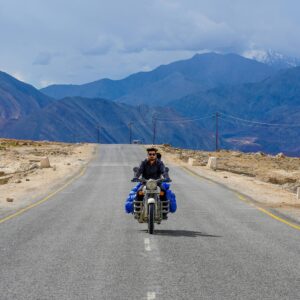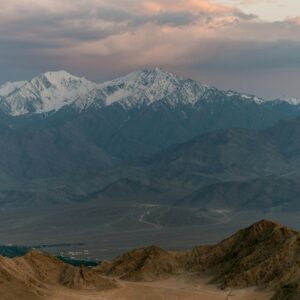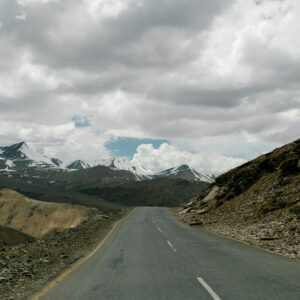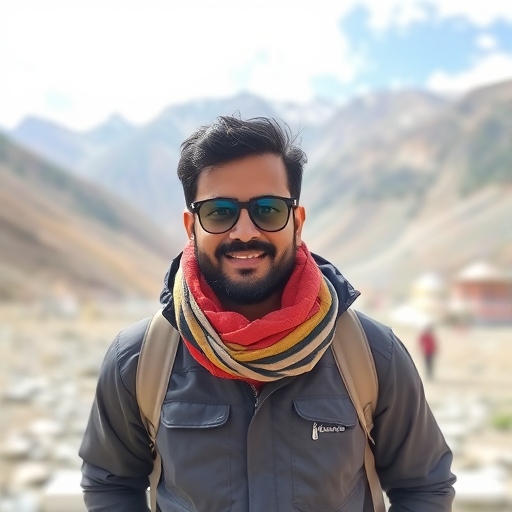"Leh was everything I had hoped for and more! From the moment I landed, I was mesmerized by the stunning landscapes—snow-capped mountains, crystal-clear lakes, and vibrant monasteries. Visiting Pangong Lake was like stepping into a dream. The serenity there is unmatched. I highly recommend Leh to anyone who enjoys adventure, nature, and culture. Just be sure to take time to acclimatize to the altitude!"
- Home
- About Us
- International
- Africa
- America
- Asia
- Australia & New Zealand
- Europe
- Middle East
AfricaEgypt
Mauritius
Zimbabve
AmericaAsiaAustralia & New ZealandEuropeCentral and Eastern Europe
Highlights
Mediterranean Europe
Middle East - Domestic
- North India
- South India
- East and North East
- Rajasthan, West and Central
North IndiaDelhi
Himachal Pradesh
Uttarakhand
Amritsar
Chandigarh
Punjab & Haryana
Uttar Pradesh
South IndiaAndaman and Nicobar Islands
Kerela
Andhra Pradesh
Tamil Nadu
East and North EastAssam
Nagaland
Tripura
Meghalaya
Rajasthan, West and Central - Temple Darshan
- Group Booking
- Blogs
- Contact Us
Sights

Explore Leh
Leh is the capital of the Indian-administered region of Ladakh, located in the northernmost part of India. Known for its stunning landscapes, Leh is surrounded by snow-capped mountains, vast deserts, and pristine rivers. The town is famous for its Buddhist monasteries, vibrant culture, and rich history, with key attractions including the Leh Palace, Shanti Stupa, and the nearby Pangong Lake. Due to its high-altitude location, Leh is a popular destination for adventure seekers, trekkers, and those looking to experience Ladakh’s unique culture and natural beauty. The best time to visit Leh is from May to September.
Places You'll See





Tour Highlights
- Well planned Tour itinerary.
- Kitchen as per our own convenience.
- Best hotels through out the tour.
- Unique tour of Scenic Beauty
- Stay in destinations that have proper facilities like hospitals, Market.
- Our groups are scheduled back to back, which is very helpful.
Tour Itinerary
Leh
Days Plan
- Morning: Arrive in Leh, the capital of Ladakh. Upon arrival, check-in at your hotel and rest to acclimatize to the high altitude (3,524 meters / 11,562 feet).
- Afternoon: Take it easy and explore the town at a relaxed pace. Visit the Leh Market to experience the local culture, shop for souvenirs, and enjoy Ladakhi cuisine.
- Evening: Visit the Shanti Stupa to catch the beautiful sunset over the town and surrounding mountains.
- Morning: Visit the Leh Palace, an ancient royal residence offering panoramic views of Leh and the surrounding valleys.
- Afternoon: Explore the Hemis Monastery, one of the largest and most famous monasteries in Ladakh, known for its stunning architecture and rich Buddhist history.
- Evening: Head to the Thiksey Monastery, a beautiful hilltop monastery that resembles the Potala Palace in Tibet. Watch the sunset from here before returning to Leh.
- Morning: After breakfast, begin your journey to Pangong Lake, located about 160 km from Leh (around 5-6 hours drive). The lake is famous for its stunning turquoise blue water surrounded by snow-capped mountains.
- Afternoon: Spend time at Pangong Lake, enjoy boating (if available), and take in the breathtaking views. Don't forget to capture photos of this iconic lake, which is also known for appearing in movies like 3 Idiots.
- Evening: Drive back to Leh and rest for the night.
- Morning: After breakfast, drive to Nubra Valley, one of the most picturesque valleys in Ladakh, famous for its sand dunes and Bactrian camels. You will pass through Khardung La Pass, one of the highest motorable passes in the world (5,359 meters / 17,582 feet).
- Afternoon: Visit the Diskit Monastery, which offers stunning views of the valley. You can also take a camel ride at Hunder sand dunes.
- Evening: Stay overnight in Nubra Valley in a local guesthouse or camp to experience the serene beauty of the area.
- Morning: Drive to Turtuk, a beautiful village near the Indo-Pakistan border. Turtuk is known for its unique Balti culture, traditional wooden houses, and lush green fields.
- Afternoon: Explore the village, interact with the locals, and visit the Turtuk Fort for panoramic views of the valley and the surrounding mountains.
- Evening: Return to Leh by evening and relax after a full day of exploration.
Notes:
• 2 passport size photos
• Adult – Original + photocopy of any of the ID proof i.e. Aadhar Card / Driving Licence / Voters ID / Passport
• Child – Original + photocopy of any of the ID proof i.e. Aadhar Card / School ID / Passport
• Infant – Aadhar Card / Birth certificate
• NRI / Foreign nationals – Mandatory Passport + Valid Indian visa / OCI card / PIO card
• Above mentioned ID proof is mandatory at the time of booking and carry the same ID proof on tour as well
Leh
Tour Details
Hear from Our
Happy Travelers

"Leh is a place that truly takes your breath away. I did a solo trip, and every corner of the town had something special to offer—be it the peaceful Shanti Stupa, the mesmerizing views from Leh Palace, or the spiritual calm at the Hemis Monastery. The people are incredibly warm, and the food is delightful. For anyone seeking peace, adventure, and adventure, Leh is the perfect destination!"

"I had always dreamt of visiting Ladakh, and Leh exceeded all my expectations. The drive to Nubra Valley through Khardung La was an adventure in itself, and Pangong Lake left me speechless. The weather was perfect during my trip (in July), and I was able to experience Leh's rich history and its incredible natural beauty. A must-visit for every traveler!"

The best time to visit Leh is from May to September, as this period offers the most favorable weather conditions for travel and sightseeing. Here’s a breakdown of the seasons:
1. Summer (May to September) – Peak Season
- Weather: This is the most popular time to visit Leh. The temperatures during the day range from 15°C to 25°C, and it can drop to 5°C to 10°C at night. The weather is pleasant and conducive for sightseeing, trekking, and outdoor activities.
- Accessibility: All major roads, including the route to Pangong Lake, Nubra Valley, and Turtuk, are open. High-altitude passes like Khardung La and Zoji La are also accessible.
- Festivals: Leh hosts various festivals during this time, including Hemis Festival (usually in June or July), which is one of the biggest cultural events in Ladakh.
- Ideal for: Adventure enthusiasts, trekkers, nature lovers, and those looking to explore Leh’s monasteries and scenic landscapes.
2. Autumn (October)
- Weather: The weather is still favorable, with clear skies and crisp air. However, temperatures begin to drop, and it can get chilly at night (around 0°C to 5°C). Day temperatures range between 10°C to 20°C.
- Accessibility: Most roads remain open, but the higher-altitude passes may begin to close due to early snowfall.
- Ideal for: Those seeking fewer crowds and the chance to experience autumn colors in the valleys. However, it’s essential to check the weather, as some roads may begin to close.
3. Winter (November to March)
- Weather: Winter in Leh is harsh, with temperatures often dipping below -10°C and even reaching -20°C or lower. The town experiences heavy snowfall, and the region becomes quite cold and isolated.
- Accessibility: Most roads, including those to Pangong Lake, Nubra Valley, and Zoji La, are closed due to snow. The only access is via air (flights to Leh may operate with limited frequency).
- Ideal for: Travelers seeking a true winter adventure or those interested in winter sports. However, be prepared for extreme cold and limited facilities.
To reach Leh, the capital of Ladakh, you have several options depending on your preferences and starting point. The most common ways to reach Leh are by air, road, and train (with a combination of other transport options). Here’s a detailed guide on how to reach Leh:
1. By Air (Most Convenient)
The most convenient and quickest way to reach Leh is by air. Leh is well-connected to major cities in India through Leh Airport (Indira Gandhi International Airport).
- From Delhi: Leh is well connected to Delhi with daily flights during the tourist season (May to September). The flight time is about 1.5 to 2 hours.
- Other Cities: Leh also has flights from other cities like Srinagar, Mumbai, and Jammu. During the summer months, flights are available from these cities, though availability may be limited in winter.
- From Leh Airport to the City: The airport is about 5-6 km from the city center. You can hire a taxi or use local transport to reach your accommodation.
2. By Road (Adventure Option)
Leh is well-connected by road to various parts of India, and many travelers prefer traveling by road for the scenic experience. However, road travel is only possible in the summer months (May to September) due to the harsh winters in the region.
From Delhi to Leh:
- Distance: About 1,000 km (approx. 2 days of travel)
- Route: Delhi → Manali → Rohtang Pass → Keylong → Leh.
- Option 1: You can take a private car or shared taxi from Delhi to Leh. The road trip through Manali-Leh Highway is breathtaking and goes through high-altitude passes like Baralacha La and Tanglang La.
- Option 2: You can also take a bus from Delhi to Leh via Manali. The journey takes about 2-3 days with overnight stays at various stops.
From Srinagar to Leh:
- Distance: About 430 km (1-2 days of travel)
- Route: Srinagar → Sonamarg → Zoji La Pass → Drass → Kargil → Leh.
- This route is open from May to October and offers stunning views of the mountains, including the Zoji La Pass.
- You can travel by private vehicle or shared taxi, and buses are also available from Srinagar to Leh.
Other Road Routes:
- Manali to Leh: From Manali, the Manali-Leh Highway is another popular route that opens in late May and remains open until October. This journey passes through Khardung La, one of the highest motorable passes in the world.
- Nubra Valley to Leh: You can travel between Nubra Valley and Leh, passing through Khardung La Pass.
3. By Train
Leh does not have a railway station, so you can take a train to Jammu or Srinagar, which are the nearest railway stations, and then travel by road to Leh.
- From Jammu to Leh: The distance is about 350 km and can be covered by road in 9-10 hours.
- From Srinagar to Leh: The distance is about 430 km and can take around 10-12 hours by road.
4. Acclimatization in Leh
Leh is located at a high altitude (around 3,524 meters / 11,562 feet), so it’s important to acclimatize to avoid altitude sickness. If you are flying directly to Leh, take it easy for the first day and avoid any strenuous activities. It’s a good idea to spend at least one day in Leh resting and adjusting to the altitude before exploring the surrounding areas.
5. Best Time to Travel
- Summer (May to September) is the best time to visit Leh, as the roads are open, and the weather is pleasant for sightseeing and adventure activities.
- Winter (November to March) can be extremely cold, and roads may be blocked due to snow, making it a less practical time for travel.

Book Now and embark on your next unforgettable adventure
With our team of seasoned travel experts and local guides, we ensure that each trip is crafted to perfection, tailored to your preferences, and filled with unforgettable memories.



